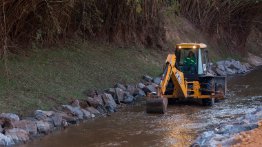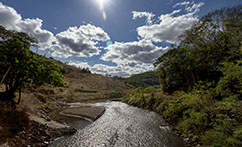23 – Tailings management
Objective of the program
To conduct studies in order to identify and assess in detail the environmental area 1 (areas compromised by the deposit of tailings in the channels and riverbanks of the Gualaxo, Carmo and Doce Rivers, considering the respective passages of their sources and tributaries, as well as the estuarine, costal and marine regions in the parts impacted by the collapse) and to manage the tailings due to the collapse of the Fundão dam, according to the results of the study included in the program, in addition to considering the environmental, social and economic factors of the region.
Approved the PMI Work Plan - Rev.07 (FR.2024.0511) through Official Letter SEMAD/GAB ADJ - CT.GRSA no. 13/2024 received on 03/13/24.
Protocol of the technical report of the J and K Campaign for Intra-channel Monitoring was carried out, at CT-GRSA (Official Letter FR.2024.0384), on 02/09/2024 to comply with CIF Deliberation 603 of 2022.
Protocol of the annual air quality monitoring report (Year 2023) was carried out at CT-GRSA (Official Letter FR.2024.0306), on 02/06/2024 to comply with CIF Deliberation 194 of 2018.
Protocol of the air quality monitoring report, referring to the 4th quarter of 2023, was carried out at CT-GRSA (Official FR.2024.0117), on 01/19/2024 to comply with CIF Deliberation 194 of 2018.
No relevant fact in the period.
Approved the physical habitat mapping study, from sections 06 to 11, by NT CT-GRSA 07/2023 and CIF Deliberation nº 729.
Protocol of the 3rd Quarterly Air Quality Management Report was carried out in compliance with CIF Deliberation 194/20218, at CT-GRSA (Official FR.2023.2588) on 10/17/2023.
Protocol referring to the Integrator Report was created with the main information and results of the hydrosedimentological studies prepared by the consultancies NHC and Rhama, at CT-GRSA (Official FR.2023.2439) on 09/27/2023.
The protocol of the proposal for the Integrated Monitoring Plan - Sections 06 to 16 - Rev.6, was carried out at CT-GRSA (Official FR.2023.2295) on 09/19/2023.
Protocol was carried out at the SEI (official letter FR.2023.2169), on 08/31/2023, of the Emissions Inventory and Atmospheric Dispersion Study Report for the municipalities of Mariana and Barra Longa – MG.
Protocol was drawn up at CT-GRSA and CIF (letter FR.2023.2155), on 08/31/2023, of the Flood Spot Study Report between Sections T13 to T15, in compliance with CIF Deliberation No. 618/2022.
1) Filing of the quarterly Air Quality Monitoring Report for the 2nd Quarter, at the SEI (letter FR.2023.1730), on 07/14/2023.
2) Filing of the Confirmatory Investigation Report of the Caatinga Site, at SEI (letter FR.2023.1849), on 07/28/2023, in compliance with Memorandum FEAM/GERAQ No. 94/2023.
3) Filing of the Final Monitoring Report of Camargos Waterfall, at the SEI (official FR.2023.1612), on 7/5/2023, in response from the Renova Foundation to item 5 of CIF Resolution No. 592.
4) Filing of the revision of the monitoring plan integrated in the SEI (letter FR.2023.1439), on 07/28/2023 of the Renova Foundation's response to the FEAM/CT-GRSA letter No. 35/2023.
5) Completion of environmental monitoring 2022-2023 5th hydrological year.
The protocol of the 5th Edition of the Plan for Monitoring Air Quality and Control of Atmospheric Emissions was carried out, at CT GRSA (Letter FR2023.1020) on 05/05/2023.
The protocol for the final delivery of the Downstream Geomorphological Study was carried out at CT-GRSA and at CIF (Letter FR.2023.1202) on 05/19/23.
Protocol related to the request for completion of Clause 160 of the TTAC (Letter FR.2023.1129) on 05/11/23
Selection report of Priority Areas for Ecological Restoration, NHC, 2023, (FR.2023.0676).
Environmental Monitoring Plan for the Pilot Project for the Recovery of Marginal Lagoons, Golder, 2023. (Letter FR.2023.0675).
Protocol of Chemical Analysis and CMB (Chemical Mass Balance) reports on air quality management in sections 06 to 12, carried out on 02/28/2023.
Protocol of the annual report on the Automatic Air Quality Monitoring Network - Year 2022, carried out on 02/01/2023.
There were no relevant facts this month.
Completion of the collections of the last monitoring campaign for the Revitalization of Camargos Waterfall.
The protocol in the CT-GRSA of the 8th Semester Report on Environmental Monitoring of Priority Interventions was carried out.
Protocol of the air quality monitoring report, referring to the 3rd quarter, was carried out on 10/17/2022.
TECHNICAL NOTE CT-GRSA No. 09/2022 regarding the analysis of the Hydrological and Hydrodynamic Modeling studies of the 2016 and 2020 Flood Spot for sections T13 to T16,
filed by the Renova Foundation in compliance with CIF resolution No. 497/2021.
TECHNICAL NOTE CT-GRSA No. 10/2022 regarding the Mapping of the 2021/2022 rainy season flood spot in the State of Espírito Santo.
62nd Ordinary Meeting of the CT-GRSA held on 09/19/22.
Protocol of the Physical Habitations report carried out on 09/01/22 (Axis 1 - item 1).
Protocol of the Bioengineering technical report and schedule carried out on 09/01/22 (Axis 1-Item3).
Review PMQQS (Lagoons, Estuary and Coastal Marine Zone) with the CT-SHQA from 12 to 14/09/22.
Management meeting held on 08/09 to address the hydrosedimentological and geomorphological study.
ComeSee in the Forest Restoration, Bioengineering projects, resumption of agricultural activities and Candonga on the 6th, 07th and 08/07/22.
Inspection of OPERATION AUGIAS regarding PHASE JUNO III.
Management meeting on the Downstream Flood Patch Modeling Study on 07/13/2022.
Protocol of the Quarterly Report of the Automatic Air Quality Monitoring Network for the 2nd quarter of 2022.
There were no relevant facts this month.
Installation of two new air quality monitoring stations in Acaica and Dom Silvério.
Delivery of the final report of the two years of study of the Deltaic Region.
Holding of the 15th WG meeting - Baixo Doce
Completion of the civil base works for the installation of air quality monitoring stations outside the ADA on 04/18/2022
Aecom technical session held on 04/29/2022
CT-GRSA Management Meeting - clarifications Technical Note CT-GRSA No. 21/2021 (Item 10.1 of Priority Axis 1)
GTBaixo Doce Meeting - closing of 2 years of studies in the deltaic region of ES, in compliance with NT CT-GRSA No. 05/2019
There were no relevant facts this month.
There were no relevant facts this month.
Campaign to collect transects in the coastal environments of the PMR16
Conclusion of 8 study campaigns in the Deltaic region in compliance with NT CTGRSA Nº5/2019 - (FR.2021.1927).
Protocol of a new version of the Technical Report entitled “Revitalization of the Camargos Waterfall: Consolidation of Management and Monitoring Actions” and the “Revised Profiling Plan” in response to items 2 and 3 of Resolution no 544 and Technical Note CT -GRSA nº. 16/2021
Protocols under Axis 2 of the ARE and ARSH documents in compliance with requests #1 and 2 of CIF Resolution 524.
Protocol for stage 01 and 02 of the ecological restoration expansion project.
Start of field activities of Stage 2 of environmental characterization of the Management Plan for Section 17
Fingerprint Study Phase 1 Outcome Report Protocol.
There were no relevant facts this month.
There were no relevant facts this month.
On 07/02/21, CT-GRSA issued Official Letter FEAM/CT - GRSA No. 20/2021 validating the revised schedule of the Tailings Management Plan for Sections 13 and 14, upon the justifications presented by the Renova Foundation and agrees that the additional period will improve the technical quality of the Plan, with effective, objective and sufficient information for better decision-making by CT-GRSA.
Filed the final report on the Study of Flood Spots downstream of Candonga (sections 3 to 16) carried out on June 30, 2021 (in compliance with items 1 and 3 of CIF Resolution No. 497/2021).
On June 2, 2001, implementation began of the Sampling and Characterization Plan of the sediment deposited in the Risoleta Neves HPP Reservoir, in compliance with condition LOC No. 38 of the HPP.
On June 18, 2021, Technical Board CT-GRSA issued a Summery of CT-GRSA Management Meeting No. 12/2021 in which CT-GRSA's agreement with the methodological scope of work presented by the Renova Foundation is registered, in compliance with items 13 and 14 of Priority Axis 1 of ACP 155bi, referring to the execution of Stage 2 of the environmental characterization of the Tailings Management Plan for Section 17 (Maritime).
Approval of the new schedule for the Post Candonga Flood Spot - CIF Resolution No. 497, of May 5, 2021.
Filed items 1, 2, 7, 8, 10, 10.1, 11.1, 12, 13 and 14 of ACP Priority Axis 1 - all in compliance - at the 12th Federal Civil and Agrarian Court on May 10, 2021.
Approval of NT No. 10/2021 on the Physical Habitat Mapping Study (Axis 1, item 1 - Indicators) on May 11, 2021.
Filed the report referring to the results of the 1st quarter of the automatic air quality monitoring network (fixed stations).
Filed the Phase 3 of the Mass Balance and Sediment Transport Studies (in compliance with item 2.1, Axis 6 of the ACP), on April 30, 2021.
The River Processes Study (Phase II), conducted by Professor Carlos Tucci from Rhama, was published in the Galileu Magazine on April 8, 2021.
Filed the Preliminary Assessment of the Caatinga site, in Barra Longa, on March 23, 2021.
Filed the technical documents to meet the environmental recovery in and out of the marginal lagoons, on March 19, 2021.
Filed the Air Quality Monitoring and Atmospheric Emissions Control Plan (Revision 3), on February 24, 2021.
Filed the 3rd by-product - Technical Digital Land Model Report, of the Flood Spot Study between HPP Risoleta Neves and the Doce River Mouth (sections 13 to 16 of the Tailings Management Plan), on February 26, 2021.
Filed the results of the 4th Campaign of the Ecological Restoration Project on February 26, 2021.
Filed the Work Plan for mapping physical habitats in sections T06 to T11 and definition of the reference condition, on January 26 2021.
Filed the Quarterly RAMQAR Monitoring Report - 4th Quarter 2020, on January 18, 2021.
Filed the Annual RAMQAR Air Quality Monitoring Report - Base year 2020, on January 28, 2021.
Filed the Hydrological Study, the 1st by-product of the Flood Spot Study post Candonga (between HPP Risoleta Neves and the Doce River Mouth - sections 13 to 16 of the Tailings Management Plan).
Start of operation of the air quality monitoring station in the municipality of Santa Cruz do Escalvado, in Minas Gerais (Operation of the station called “Novo Soberbo”).
Meeting with Resplendor residents about studies carried out by the Waste Management Program.
Start of field work for characterization and consolidation of the Sections 13 and 14 Management Plan, in compliance with the Technical Note CT-GRSA 13/2020.
Marilândia Accountability Forum on the reparation and indemnity actions performed by Renova Foundation, with the presence of the Tailings Management and Doce River Basin Monitoring programs.
Presentation on PG23 actions in the thematic meeting with representatives from the government of MG, held by the FR's RI area.
conteúdo de julho
Public Civil Action
• Request, to the Federal Judge of the 12th Federal Civil Court, for the suspension of the deadlines set for items 3, 4 (ii), 5.1, 6, 6.1, 6.2, and 15 of Axis 1, until the COVID-19 situation normalizes and allows the continuity of fieldwork without any risk to employees, communities, and others involved.
• Presentation to the Federal Judge of the 12th Federal Civil Court of the claim regarding the analysis of the AECOM work plan for food safety.
• The monitoring report of the behavior and dynamics of the interchannel tailings in the Gualaxo do Norte, Carmo, and Doce rivers, up to HPP Risoleta Neves, for the rainy period 2019/2020, with an assessment of the effectiveness of the lag layer, were submitted in the CIF System.
• Phase 1 of the environmental characterization of the marine tailings management plan (tailings management plan for section 17) was submitted in the CIF System.
Public Civil Action (ACP)
• Training the technical team who monitors the assessment of risks to human health in the district of Povoaçao in Espirito Santo.
Tailings Management Plan
• The Technical Board for Tailings Management and Environmental Safety (CTGRSA) has approved the work plan for consolidating transects of the Management Plan for Sections 13 and 14.
• Surveying and classifying of the main impact of removing and disposing of waste in the Risoleta Neves hydroelectric power plant reservoir on physical, biotic, and socioeconomic environments.
Public Civil Action (ACP)
• Presentation, through the CIF System, of the Monitoring Plan for the implementation of the Tailings Management Plan, considering the indicators and goals discussed in the scope of the Public Civil Action.
• Delivery, through the CIF System, of the Management Plan for Section 16.
• Presentation, through the CIF System, of the Intervention Plan in the Pilot area (area studied in Areal/ES), according to the Consolidated Report of the Risk to Human Health Assessments carried out in the State of Espirito Santo, using the conclusions of GAISMA.
• Presentation, to the 12th Federal Court in Belo Horizonte/MG, of the formulation of proposals for the collection, study, storage and methodology of processing biological material, aimed to assist and supplement the inspection related to fish food security, as well as agricultural products irrigated directly with water from the Doce River.
Public Civil Action (ACP)
• Submitted the detailed schedule for the expansion of the Ecological Restoration Project in other areas of the Gualaxo do Norte, Carmo and Doce rivers, with a total reach of 2 km.
• Submitted in the CIF System, the monitoring report of the behavior and dynamics of the interchannel tailings in the Gualaxo do Norte, Carmo and Doce rivers, up to HPP Risoleta Neves, in the 2019 dry season.
• Submitted in the CIF System, the integration and consolidation plan of the intra and extra-tailings management actions for Sections 1 to 17.
• Submitted in the CIF System, the "Ecological Risk Assessment" study of the pilot areas in MG (studied areas in Barra Longa) and ES (studied areas in Areal).
• Submitted in the CIF System, the proposal for the adoption of effective measures for the reduction of dust in residences located in the localities affected by the tailings mud and public equipment.
• Submitted in the CIF System, the risk to human health assessment, up to Phase III, for the district of Povoaçao in Espirito Santo.
Public Civil Action (ACP)
• Submitted, through the CIF System, the consolidated document with the reviewed scope of the indicators and targets of the actions related to the tailings management in sections 13 to 16.
• Submitted, through the CIF System, the studies for modeling the marine dynamics of sediments in section 17.
• Submitted, through the CIF System, the Tailings Management Plan for section 15.
• Submitted, through the CIF System, the partial report referring to the studies of environmental monitoring campaign 03 of the pilot project for ecological restoration carried out in the Gualaxo do Norte.
Air Quality Management
• Implementation of the air quality monitoring station in Rio Doce/MG. Operation started on 02/06/2020.
Complementary studies
• Completion of the analysis and evaluation of existing information (phase 1) to prepare studies on river and sediment processes downstream of the Fundao dam.
Tailings Management Plan
• On 01/24/2020, the Ecological Restoration Monitoring Report of the Pilot Project for sections 6 and 7 of Campaign 3 was filed with the Technical Board for Tailings Management and Environmental Safety.
Air Quality Management
• On 01/20/2020, the Chemical and Morphological Analysis Reports were filed, for the periods from January 2018 to March 2019, and August 2018 to April 2019. This study aims to chemically and morphologically characterize the inhalable particles, to support the application of the Chemical Mass Balance Receptor Model.
Contaminated Area Management
• On 01/30/2020, a meeting took place between the coordinators of the Renova Foundation to define the strategy for the project Integrated Environmental Management for Health and Environment (GAISMA), after judicial validation. In addition, the GAISMA methodology was presented, as well as the definition of the deadlines agreed in the Public Civil Action.
Complementary studies
• On 01/08/2020, the delivery took place of the final report of the feasibility studies for the removal of sediment banks from the Gualaxo do Norte River.
Tailings Management Plan
On 12/20/2019, the letter referring to the completion of the field collection campaigns in sections 15 and 16 of the Tailings Management Plan and Deltaica Region, was submitted to the Technical Board for Tailings Management and Environmental Safety.
The works to recover the Camargos Waterfall have not started. Cause: need for new adjustments to the project, removing the interventions foreseen in the permanent preservation area (PPA). Countermeasure: the detailed project was completed on 09/10/2019 and filed with SEMAD, which issued environmental authorizations on 11/28/2019; the recovery works for Cachoeira Camargos are scheduled to take place in November 2020.
The approval of all Management Plans by the environmental agencies did not occur. Cause 1: The Management Plan for Section 5 will only be approved by the Technical Board (TB), after defining the future use of the Bento Rodrigues area and investigating the uncertainties about the decommissioning of Dike S4. Cause 2: the Tailings Management Plan for Section 12 will not be analyzed by the TB until it is reviewed and updated, taking into consideration the Phase I studies (definition of alternatives, technical solutions and description of the actions to be applied in the environmental management of Hydroelectric Power Plant Risoleta Neves). The expected deadline for the approval of the tailings management plan for this section is September 2020. Cause 3: the Management Plan for sections 13 and 14 is being analyzed by the TB; the expected deadline for the approval of the tailings management plan for this section is June 2020. Cause 4: The Management Plan for section 15 should be revised to take into account the new transects and modeling. The expected deadline for the approval of the tailings management plan for this section is November 2020. Cause 5: the Management Plan for section 16 should be revised to take into account the new transects, modeling and inclusion of the different affected environments. The expected deadline for the approval of the tailings management plan for this section is January 2021. Countermeasure 1: wait for the definition of the affected residents about the final designation of the area buried by the tailings and occupied by correctional projects installed by the Renova Foundation; and define the future of Dike S4 with the Public Authorities and the affected community. Countermeasure 2: update the Management Plan for section 12 based on the Phase I studies (definition of alternatives, technical solutions and description of the actions to be applied in the environmental management of HPP Risoleta Neves), expected to be concluded in June 2021. Countermeasure 3: wait for validation of the management plan by the TB and make the requested adjustments. Countermeasure 4: carry out the necessary revisions in the management plan of the section, taking into account new transects and modeling. Countermeasure 5: carry out the necessary revisions in the management plan of the section, taking into account new transects, modeling, including the Estuary, Mangrove, Sandbank and Beach environments and the Areal, Monsaras and Pandolfi Lagoons in section 16.
Impact Assessment for the Lower Doce Lagoons
On 12/09/2019, the assessment of the technical feasibility of the removal of the surface layer from the sediment banks of the Gualaxo do Norte River was submitted to the Technical Board for Tailings Management and Environmental Safety.
On 12/11/2019, the stability studies of the emergency barrier installed in the Pequeno River, a channel that connects the Doce River to the Juparana Lagoon in Linhares, were concluded.
Tailings Management Plan
• Filed to the CIF was the report on erosion control actions mapped in hydrological period 2019/2020 in compliance with item 3 of Thematic Axis 1 of Public Civil Action 69758-61.2015.4.01.3400.
• Presentation in Governador Valadares of the Tailings Management Plan for stretches 13 and 14 to the Commissions of Affected Parties and municipalities of the Doce River Basin, in the area between Rio Doce/MG and Baixo Guandu/ES.
• Presentation of the Candonga Reservoir 1D Hydro-sedimentological Modeling Study developed by Potamos to the Candonga Reservoir Recovery Program and Consortium Aliança for drafting the chapter of the Addendum to the Basic Design - Package 4. (Source: P23-LSP-001-00_Modeling Presentation Meeting 1D_191203.jpg);
• Termination of engineering project for tailings disposal area for stack 6A;
• Meeting between the Municipality of Barra Longa, Civil Defense, Dialogue team, Renova Foundation Tailings Management Program and HidroBR company to discuss the release of access of superficiaries to the territories that are part of the field survey of the Barra Longa flood study.
Contaminated Area Management
• Presentation in Belo Horizonte/MG of the report on the consolidation of the Human Health Risk Assessment Study (ARSH) to the government of Minas Gerais, the Ministry of Health and auditors (Aecon and Ramboll).
• On 10/04, Environmental Monitoring Campaign 3 was completed, after the implementation of the Ecological Restoration Project, which aims to verify the effectiveness of the project.
• On 10/07, the Chemical and Morphological Analysis Reports for the periods from July to December 2017 and January to August 2018 were filed, in accordance with the actions provided for in the Air Quality and Emissions Monitoring Plan.
• On 10/16, there was a lecture at the Governador Valadares Pythagoras College on the Renova Foundation's Tailings Management Program and the main findings of the characterization of tailings as well as Risk to Human Health Projects and of the water quality monitoring (PMQQS).
• On 10/18, were completed the updates to Model 1D (descriptive synthesis study of the methodology and main results of hydrological and sedimentological characterization) of the Doce River fluvial area, which covers the insertion area of the Risoleta Neves HPP.
• On 10/22, the environmental studies were filed related to the Public Civil Action of the Linhares Lagoons, which aim to technically support decision-making on the most appropriate definitive alternative for these environments, considering the potential for contamination and the social and environmental viability for the construction of permanent dams.
• On 10/30, the field campaign was initiated to carry out new transects in stretches 15 and 16, in compliance with CT-GRSA, to consolidate the Management Plans for these stretches.
• The delivery of the feasibility and effectiveness study for the removal of prioritized sediment banks in stretches 6 to 9 on the Gualaxo do Norte River was rescheduled for December/2019 due to the need for technical review by the designer.
• Completion of the Storage Area for Stack 6A of the interchannel project has been rescheduled for November/2019 due to revisions to the project. This delivery aims to finalize the engineering project of the tailings disposal area.
• On 09/02/2019, completion of the detailed review of the Camargos Waterfall recovery project - which aims to align the project presented as requested by the environmental agency.
• On 09/23/2019, Tailings Management Plan was partially approved through CIF Resolution 323 for stretches 10 and 11, related to the outer-channel tailings deposits.
• The delivery of the Deposit Area for Stack 6A of the Interchannel project - which aims to finalize the engineering project of the tailings disposal area - was rescheduled for October 19 due to project revisions.
• The delivery of environmental studies related to the Public Civil Action of the Linhares lagoons - which aims to technically support decision-making on the most appropriate definitive alternative for these environments, considering the potential for contamination and the social and environmental viability for the construction of permanent dams - has been rescheduled for October 19, as validation and review of the reports produced are required.
• On 08/20/2019, the air quality data of the municipalities of Mariana and Barra Longa (MG) were validated, and the air quality was classified as “good” by the Technical Board CT-GRSA.
• On 08/20/2019, the management plans for sections 10 and 11, referring to the municipality of Barra Longa (MG), were approved by CT-GRSA.
• On 08/27/2019, the phase-2 end report of the ecological restoration was submitted, which corresponds to the implementation of logs in the Gualaxo do Norte River Channel, in stretches 6 and 7 (in Mariana, MG).
• On 07/10/2019, the 2017 Inventory of Atmospheric Emissions was filed with CIF, which aimed to identify and quantitatively estimate activities that could potentially change the air quality in the region from Mariana/MG to Rio Doce/MG.
• On 07/19/2019, the implementation of phase 2 of the ecological restoration project was completed, in which trunks were installed in the Gualaxo do Norte River Channel in stretches 6 and 7.
• On 07/29/2019, was approved, through CIF Resolution no. 304, the Tailings Management Plan related to the interchannel tailings deposits in section 8 (municipality of Mariana/MG).
• Obtain Licenses, Approvals and Authorizations for the Recovery of the Camargos Waterfall. This delivery is intended to resume community recreation activities, however, due to the new alignment with the environmental agency of the licensing strategy this milestone was suspended.
• Complete Deposit Area for Stack 6A of the Intracalha project. This delivery aims to finalize the engineering project of the tailings disposal area. Delivery has been rescheduled to August/2019 due to design revisions. This delivery refers to Milestone “Stack Deposit Area 6A Completed”.
• On 06/04/2019, it was recommended by AECOM not to construct conventional and/or alternative physical structures for 9 of the 11 Linhares ACP lagoons, as the sediment characterization results indicate that there has been no contact with the Doce River.
• On 06/07/2019, the placement of 76 logs in stretch 7 was completed, for ecological restoration, along 500m on the Gualaxo do Norte River in the municipality of Mariana (MG).
• On 06/14/2019, the 1st Workshop on Studies of River and Sediment Processes Downstream of the Fundao Dam was held, to present the complementary sample network, methodologies and discussion of the analysis criteria.
• Obtain licenses, grants and permits for the recovery of the Camargos Waterfall. This delivery is intended to resume recreational activities of the community and was rescheduled for Jul/19.
• On 05/08/2019, a letter was filed with the environmental agencies and TB - in compliance with request 1 of NT 07/2018 - regarding the Study of the Potential Contamination Risk of the waters of the Doce River.
• On 05/13/2019, the Risk to Human Health Analysis was contracted, per standards of the Ministry of Health (Ambios shadowing).
• On 05/15/2019, management solutions were presented in the WG Rural Area, the community learned about waste characteristics and management solutions.
• On 05/16/2019, the Technical Board CT-GRSA communicated the need for licensing for the ETN project developed by LiaMarinha, in the Gualaxo do Norte River.
• On 05/17/2019, the civil works of Cachoeira de Camargos were concluded.
• On 05/30/2019, IBAMA inspected the ecological restoration project and the project progress was verified.
• Completion of the implementation of the air quality monitoring station in Santana do Deserto, in Rio Doce (MG).
• Delivery of the Flood Spots Modeling Report for the floods of 2016 (stretches 13 to 16).
• Completion of Phase 1 of the ecological restoration project (Engineering).
Completion of the studies on the stability of the emergency barrier installed in the Pequeno River, a channel that connects the Doce River to the Juparana Lagoon in Linhares.
Activation of the Contingency Plan (level 2) for the evacuation of the families living downstream of the Pequeno River.
Presentation of water quality and sediment data to AGERH, IEMA and SAAE/Linhares.
Presentation to IBAMA and SEMAD of the final results of the diagnostic campaigns and executive project for ecological restoration of Stretches 6 and 7, Gualaxo do Norte River.
Presentation of the pilot project of the Natural Treatment Station (ETN) of the company LiaMarinha, Stretch 6, Gualaxo do Norte River, to the Technical Board CT-GRS, to obtain the environmental authorizations.
Presentation to FEAM of the new projects and status of air quality monitoring between Mariana and Rio Doce. The feedback from the agency was very positive, praising the implementations, results achieved and transparency of the information.
Meeting with the community of Itueta, where the results were presented of the sediment analyses and volume deposited in the reservoir of the Aimores HPP, at the request of the community.
The Executive Project of the Camargos Waterfall was presented to, and approved by, the local community.
The species list for conducting the Ecological Risk Analysis was filed with the Technical Boards CT-Bio and CT-GRSA.
Waste collection activities took place at the Fundao dam and in Candonga (sectors 6 and 11) to classify solid waste in the sandy and clayey fractions of the tailings.
Measurement of liquid and solid discharges and sediment collection (suspension, drag and river bed) in the Gualaxo do Norte River for the hydro-sedimentological study of the 1D / 2D model of Candonga.
The Management Plans for stretches 10 and 11, located in the municipality of Barra Longa (MG), were filed with the Technical Board CT-GRSA. The Management Plans define the solutions to be applied in each section, such as revegetation and erosion control, including the monitoring carried out by the Biodiversity Program. After analysis and approval by the Technical Board (CT) and Interfederative Committee (CIF), the implementation of these plans will be initiated.
Postponement by the Technical Board CT-GRSA of the protocol for the Management Plans of stretches 13, 14, 15 and 16 (covering the municipalities downstream of Candonga) for Jun /19. A floodplain modeling of the 2016 flood is prepared to determine the area of impact beyond the river channel, expected to be completed in April/19.
Finalization of egg, milk and foliaceae collections by EPA for Risk to Human Health Analysis in Barra Longa (MG). Metal concentrations will be verified and compared with the results released by AMBIOS (contracted by PG014).
Field visits were made to start the services related to the Ecological Risk Analysis by the contracted company (Golder Associates) in the pilot areas (Linhares and Barra Longa) to locate the sites to be studied. The final report of the analyses in these areas is expected to be filed with CT-GRSA in Feb/20.
Field visit of the Infra team of the Renova Foundation to schedule works for the installation of two fixed stations for monitoring air quality (Rio Doce and Santana do Deserto, Minas Gerais). The works are scheduled to be completed in April/19.
Presentation of the alternatives for definitive dams for the Pequeno River and Juparana Lagoon in the Technical Board CT-GRSA, with the participation of IDAF, SAAE, Intersectoral Commission of Linhares (ES) and other environmental agencies that make up the Technical Board.
Signature of the Term of Acceptance by the Secretary of the Environment of Sooretama (ES), referring to the conclusion of the mechanized removal of macrophytes in the portion of the Juparana Lagoon in the community of Patrimonio da Lagoa.
- Filed with the Technical Board were the Management Plans for stretches 5 and 17
- Completion of tailings earthworks in Barra Longa
- Approval by the CIF of the Management Plan for stretch 9
Conclusion of sediment collections in five lagoons (Terra Alta, Terra Altinha, Camargos, Palmas and Palinhas) as part of the Public Civil Action against Samarco, in response to the request of the Prosecution Service and local community in order to confirm if tailings entered these lagoons or not. The collections were carried out by the Renova Foundation and attended by the local community.
Filed with the Technical Board for Tailings Management and Environmental Safety (CTGRSA) the protocol of the Management Plan for Stretch 12 (Phase 2 of Candonga).
Completed the chemical and morphological analysis of dust (Campaign 4 - collections between January and July/18) to verify the presence of tailings dust in the air inhaled by the people of the communities located between Mariana and Rio Doce (MG). The results of the impacts will be released in April/19.
Started the environmental licensing process for the works to recover the Camargos waterfall, located in a district of Mariana (MG) near Bento Rodrigues.
Visit by Ramboll for audit of Stretches 1 to 7 (Mariana) and 15 and 16 (Linhares).
Approved by the CIF are the Work Plans for Stretches 6 and 7 (Mariana), the definition of the scope of Programs 23 (Tailings Management) and 24 (Sediment Containment) and of the Assessment of the Impact to the Physical Environment (Clause 150).
Sediment collection was carried out in six lagoons (for Public Civil Action against Samarco) in response to the request of the Prosecution Service and local community to confirm if the tailings reached these lagoons or not. Collection conducted by the Renova Foundation with presence of the local community.
Activities to remove macrophyte were initiated in the Pequeno river and in the area of Patrimonio da Lagoa, in order to improve the environmental and social condition of the environments and to mitigate the risk of compromising the Linhares (ES) public water supply system.
The community approved the project to recover the Camargos Waterfall (recreation area of the community affected by the collapse) to remove tailings from the pond of the waterfall and revegetation of the riparian forest;
Completion of the works to open the barriers in the Bananal and Pequeno River to reduce flooding in the Juparana and Nova Lagoons;
Completion of the evacuation of families living downstream of the Pequeno River Barrier in Linhares/ES;
Conclusion of dredging of the flooded area in Sooretama/ES.
Initiation of works to increase the lateral extravasation channel of the Juparana lagoon to reduce flooding. The works were paralyzed for 5 days (between 08/16/18 and 08/21/18), due to the judicial questioning about the need for licensing, and then resumed shortly after with the Judge's consent.
Management Plan for Stretch 9 was completed and filed with the Tailings Technical Board.
Irrigation study filed with the CIF and TB-Tailings, for analysis and validation of compliance with clause 180. After validation, an action plan will be created to meet the points identified in the assessment.
Mobile air quality monitoring services started in Barra Longa/MG with expected completion in Oct/19. The objective is to verify locally the exposure of people in a complementary way to the fixed implemented stations.
Received the authorization of IBAMA for monitoring aquatic fauna (fish, birds, amphibians and other organisms). This project is aimed at the use of logs and timber anchored in the river bed to attract fauna and provide conditions to increase biodiversity in the environment.
Meetings were held at the FEAM in MG and ES to present the study of risk to human health and technical alignments of the weaknesses identified in the Term of Reference recommended by the environmental agencies. It was defined that the final version will be submitted on 09/20/18, including the results of the analysis of risk to human health and also containing the definitive scope of application of the risk to human health study in the other territories. The target areas will be the same as those defined in the TB of Health.
Completion of the Program’s Communication Plan.
The program team presented an action plan to the Technical Board of Social Organization and Emergency Aid (CTOS) to mitigate the impacts of the floods in the areas near the Pequeno River and the Juparana Lagoon.
In addition, the management plan for the Juparana, Nova, Monsaras, Areal and Pandolfi lagoons in Linhares (ES) was submitted to the Tailings Technical Board. For the Juparana Lagoon, the plan presented low risk of contamination by the Doce River and it proposes the withdrawal of the barrier in the area, which was installed after determination of a Public Civil Action.
This month, the community also had the opportunity to learn about the work plan for the revitalization of the Camargos Waterfall. Topography and bathymetry for engineering were also completed.
Another completed activity was the elaboration of a technical report that deals with the identification and diagnosis of the irrigation systems affected by the Fundao dam collapse.
In addition, the company AECOM was contracted. It will carry out an independent technical audit with the Prosecution Service of Espirito Santo on the decision-making process regarding the Linhares Lagoons.
The agroforestry operation teams that work between Barra Longa and Mariana received training on the Tailings Management Program.
Furthermore, the Ramboll inspection (audit contracted by the Federal Prosecution Service) in section 8 of the Tailings Management Plan was monitored. The objective was to verify the progress of the forest restoration activities and natural treatment and tailings removal systems.
The company Embauba Ambiental began reviewing irrigation studies to assess the impact caused by the collapse of the dam in these systems and the possibility of soil contamination.
Semad stated that the environmental recovery of channels, banks and plains must be done by managing tailings in the river bed, following the management plan time frame.
The Tailings and Health Technical Boards stated that the data produced by the studies conducted under the Tailings Management Program can be included in health studies, aiming at synergy and avoiding duplicity.
The installation of the Gesteira air quality monitoring station was also completed and the station is now operational.
The Section 8 detailed sediment behavior results are also out, and indicate tailings removal, which leads to concluding that the river is recovering naturally and does not require major interventions in the channel. The report was presented to the Tailings Management Technical Board.
The assessment of the silting prognosis for the reservoir before and after the dam collapse was completed.
Moreover, the installation of the air quality monitoring station within the Rio Doce municipality was approved.
The 20th meeting of the Tailings Technical Board took place, in which the following topics were discussed:
• Construction of barriers in Linhares;
• Definition of scope and indicators of Tailings Management;
• Term of reference for the ecological risk assessment;
• Management plan for stretches 1 to 4;
• Erosion control and bioengineering works.
The Management Plan for stretches 6 and 7 was approved by the environmental agencies and Technical Board.
In addition, the contract was signed with the company responsible for reviewing the irrigation study.
Works to take care of the tailings have started in stretch 8, in the Gualaxo do Norte river, in the region of Mariana (MG). It concerns the enrichment of the vegetation on the flood plains with native species, as foreseen in the management plan. This work will continue until 2019.
The Term of Reference for the Ecological Risk Assessment was delivered to the Tailings Management Technical Board in the pilot areas. The proposal is to carry out the pilot of the ecological risk assessment in the same area in which the pilot of the risk to human health assessment is taking place.
Also, in this period, TWC technology was implemented, which consists in the use of wax plates enriched with nutrients that allow the development of microorganisms that degrade the pollutants of the river, improving water quality. It is an alternative technology that is being tested by the Renova Foundation.
In regard to the activities carried out in the Linhares (ES) lagoons, the reports on the stability of the emergency barriers and conceptual designs of the definitive barriers were submitted, in response to a judicial decision and IBAMA notification. There was also a judicial decision for the immediate construction of the definitive barriers in the Nova and Juparana lagoons. The reports concluded that the previously installed barriers are stable from a geotechnical point of view. The management plan for these lagoons will be completed in May.
Fieldwork (sample collection) was also completed in March, and the hydro-sedimentological study for phase 2 of Candonga was finalized. The management plans for stretches 10 and 11 were finalized at the end of this month.
The Engineering Plans for the elaboration of the executive projects of the Natural Treatment System (STN) and for the removal and deposition of tailings from the Stretch 8 channel (which will be the pilot of the Gualaxo do Norte river) were submitted to the Tailings Management Technical Board.
The Term of Reference was also presented to the Technical Board to redo the study to identify irrigation areas (Clause 180 of the CIF), since the previously presented study did not comply with said clause.
Filed with the CT were the plans for handling Stretches 6 and 7, and 1 to 4 for their evaluation.
Completion of well and soil and groundwater collection installations for the Health Risk Analysis pilots in Barra Longa (MG) and Areal (ES).
Underway are the probing activities and the physical-chemical analysis for the definition of the tailings management procedures along the Gualaxo do Norte, Carmo and Doce rivers, in Minas Gerais. These activities have the purpose of estimating the volume of tailings deposited in the channels, banks and slopes of the impacted rivers.
The work plan of the Ecological Restoration Project, to obtain the environmental license of fauna management and alteration of the area of execution of the Project, was delivered to the environmental agencies that make up the Tailings Technical Board. Now, the technology pilot will be deployed in sections 6 and 7, both at the Gualaxo do Norte river, in Minas Gerais. The Application of the Tailings Management Plan for sections 6 and 7 was also delivered, which defines the conceptual solutions for the management of tailings that cause less social and environmental impact in the areas. In the region of the Carmo River and the Risoleta Neves Hydroelectric Power Plant, the environmental characterization was carried out to define the management plan for sections 10, 11 and 12.
To support the projects of the Tailings Management Plan, the contracting of the topographic bathymetry services for the Gualaxo do Norte and Carmo rivers was concluded.
Regarding the Human Health Risk Analysis study, the installation of more than 40 groundwater monitoring wells was completed in the pilot areas of Barra Longa and Linhares, Espirito Santo.
The drilling activities and the physical-chemical analysis for the definition of the tailings management procedures proceeded along the Gualaxo do Norte, Carmo and Doce rivers. These activities have the purpose of estimating the volume of tailings deposited in the channels, banks and slopes of the impacted rivers.
The field inspections and the work plan were completed for the execution of the ecological restoration project of the section 8 pilot area. The project will consist of the installation of logs on the river bed, which will help control erosion and increase the diversification of physical habitats, increasing fish proliferation and biodiversity.
Renova started the contracting process for the service to create the term of reference for carrying out the sediment transportation study in the rivers Santarem, Gualaxo do Norte, Carmo and Doce. It also hired a consulting firm to conduct a human health risk analysis and to conduct studies in two pilot areas in Minas Gerais and Espirito Santo. Two consulting firms specializing in peer review were contracted to review the environmental studies of high complexity developed by the Renova Foundation.
Research and analysis was also started on the human health risks in the two pilot sections in Minas Gerais and Espirito Santo. Geophysical analyses were carried out to select the location for drilling and installation of wells to sample soil and groundwater. In two meetings, with the support of the Dialogue team, the beginning of the activities was explained to the communities.
This period was also marked by the putting into operation of the third automatic air quality monitoring station in the community of Paracatu de Baixo (MG), the first one installed in Mariana.
The team put into practice rainy season emergency actions at the dikes of the Nova lake and the Juparana lake and began its detailed monitoring activities for the rainy season in section 8, which includes the evaluation of sediment banks, bathymetry, liquid and solid discharges.
The Tailings Management Plan started its implementation activities, which will define the necessary rehabilitation processes for the 17 stretches of the Doce River. They consist of probing services and physical-chemical analyses, with the purpose of estimating the volume of tailings deposited in the channels, banks and slopes of the impacted rivers.
Field studies for the application of the management plan are being developed on two fronts: in the Gualaxo do Norte River, upstream from the Candonga reservoir and in the potentially impacted lagoons in Espirito Santo.
For the execution of the renaturalization project of the pilot area of stretch 8, field meetings and inspections were initiated. The project will consist of the installation of logs on the riverbed, with innumerable benefits to the environment, such as river erosion control and increased diversification of physical habitats, for fish proliferation and biodiversity.
Renova began the contracting process for the service for the elaboration of the term of reference for carrying out the sediment transportation study in the rivers Santarem, Gualaxo do Norte, Carmo and Doce. Also hired was the consulting firm responsible for the human health risk analysis, to prepare studies in two pilot areas, in Minas Gerais and Espirito Santo, and two consulting firms specialized in peer review. This service will be used for reviewing highly complex environmental studies, elaborated by the Renova Foundation.
The Geochemical Study, for chemically analyzing samples of tailings, sediment and affected and not affected soil along the Doce River, was reviewed and filed with the Technical Board of Tailings and Environmental Safety and the Interfederative Committee (CIF). It was submitted for the first time in July 2016, in compliance with the Transaction and Conduct Adjustment Term (TTAC). End 2016 and early 2017, the environmental agencies sent technical notes with the items reviewed in the latter version.
Work began on the implementation of the Tailings Management Plan, which will define the rehabilitation processes for the 17 stretches of the Doce River. These activities are services with probes and physicochemical analyses to estimate the volume of tailings deposited in the channels, banks and slopes of the impacted rivers.
Field studies for the application of the management plan are being developed on two fronts: in the Gualaxo do Norte River, upstream from the Candonga reservoir and in the potentially impacted lakes in Espirito Santo.
The initial meetings and field inspection began for the execution of the Renaturalization project of the pilot area of stretch 08.
The project will be installing logs in the river channel, with benefits to the environment, such as erosion control of the river and increased diversification of physical habitats, to increase fish abundance and biodiversity.
Renova began the process of contracting the term of reference for carrying out the study of sediment transport in the rivers Santarem, Gualaxo do Norte, Carmo and Doce. The consulting firm responsible for analyzing the risk to human health was hired to prepare studies in two pilot areas in Minas Gerais and Espirito Santo. Two consulting firms specializing in Peer Review (third party review) were also hired. This service will be used in the review of highly complex environmental studies developed by the Renova Foundation.
The Geochemical Study was reviewed and filed with the Technical Board of Tailings and Environmental Safety and with the CIF. In this study were analyzed samples of tailings, sediment and soil - affected and not affected - along the Doce river. It was submitted, for the first time, in July 2016, in compliance with TTAC clause 150. End 2016 and early 2017, the environmental agencies sent technical notes with the items that were revised in the latter version.
Contracting of the supplier of biodegradable product for dust suppression of unpaved traffic ways, between the municipalities of Mariana and Rio Doce, in Minas Gerais, used for the traffic of vehicles of the Renova Foundation involved in the environmental repair works.
Another contract was closed for the Waterway Restoration project, also called Renaturalization. This project (pilot) will consist of the installation of logs in the river bed to restore Section 8 of the Tailings Management Plan, located in the Gualaxo do Norte river and close to the Small Hydroelectric Power Plant (PCH) Bicas, with numerous benefits for the environment. The restoration of the stretch has the general objective of engaging local communities in the process of controlling river erosion and increasing the diversification of physical habitats to increase fish abundance and biodiversity.
The specialized company that will implement the Tailings Management Plan in the remaining 16 stretches was also defined. This service will define conceptual management solutions for each area, which will be validated by the members of the Technical Board for Tailings Management and Environmental Safety.
The review of the Study for Identification of Irrigation Areas along the Doce River, covering a stretch of margin along the Doce River with a width of 1km on each side, was filed by the Technical Board for Tailings Management and Environmental Safety, the Technical Board of Infrastructure and Technical Board of Economy and Innovation. During the review, the following changes were incorporated: updating the results of soil analyses, complete database, with geoprocessing information and owners, and maps of properties identified and surveyed in the study.
Filed with the Technical Board for Tailings Management and Environmental Safety are the revised version of the Tailings Management Plan and the implementation of the plan for the stretch that covers a nine-kilometer area between Mariana and Barra Longa, in Minas Gerais.
In the locality of Volta da Capela, in Barra Longa (MG), the second automatic air quality monitoring station was installed and put in operation.
Conclusion of the study of the physical-chemical analyzes carried out in the lagoons Nova, Monsarás, Areal and Pandolfi, in Espirito Santo. The results showed that the levels of metal concentrations in the water and impacts caused by the tailings plume do not justify the need to remove sediments from their channels.
The Ecological Risk Analysis Workshop was held at the Dom Cabral Foundation (FDC), in partnership with environmental agencies. The event was attended by experts, who discussed the methodologies that will be used to identify the risks of the presence of the tailings to the environment and the local ecosystems.
Conclusion of the comparative scenario study for removal and non-removal of the tailings stack at the Barra Longa Exhibition Park, in Minas Gerais. The study showed that the scenario with the lowest impact on air quality is that of non-removal, using the tailings for elevating the soccer field. This solution is in progress.
The revised Working Plan - Tailings Management for Bento Rodrigues (MG) was also completed and filed with the Technical Board for Tailings Management and Environmental Safety.
On June 08, the Candonga Waste Management Plan was presented at the 11th Tailings Management Technical Board meeting. The plan sets out guidelines on the tailings contained in the hydroelectric plant in a medium and long-term vision.
In Barra Longa (MG), the construction of two infrastructures for air quality monitoring stations in the Gesteira district and in the Volta da Capela neighborhood is in progress. In Gesteira the progress of the process is 50% and in Volta da Capela it’s 90%. The two new structures are part of the expansion process of the air quality monitoring network. Planned within this process is the refinement of the dispersion models of particulate materials in their various granulometries. The construction of these stations is being monitored by the State Environmental Foundation (Feam), which will receive the monitoring data in real time, similar to the station in operation in the municipality of Barra Longa.
The Barra Longa Annual Air Quality Monitoring Report was filed with the environmental agencies Feam, Tailings Technical Board (CT-Rejeitos) and the Brazilian Institute of Environment and Renewable Natural Resources (Ibama). The air quality range in Barra Longa is classified as good and regular in the monitored period (02/18/2016 to 02/18/2017), taking into account the limits established by Conama Resolution nº 03/1990 for daily and annual averages of measured pollutants, except for the PTS, which presented extrapolation episodes of the Conama standard for daily averages in the month of October/2016.
The tailings management plan for the Gualaxo do Norte River was revised and re-filed with the environmental agencies. The basic projects involving the treatment of river water were completed. The documents were submitted to the Tailings Technical Board for approval and subsequent implementation.
Environmental clarifications were also filed with the environmental agencies regarding the main document of the Tailings Management Plan.
In addition, the technical team of the Renova Foundation visited the company DT Engenharia to learn about the direct treatment technology in the channel of the watercourse, called Flotflux, which allows the removal of solids more effectively. Flotflux was incorporated into the Tailings Management Plan as one of the possible solutions for the Gualaxo do Norte River.
The Doce River Basin Tailings Management Plan was filed on April 20 with the Brazilian Institute of Environment and Natural Renewable Resources (Ibama), the State Environmental Foundation (Feam), the State Institute for the Environment and Water Resources (Iema) and the State Department of Environment and Sustainable Development of Minas Gerais (Semad). This step is important for obtaining the approval of the bodies and initiating the actions. The document describes guidelines, methods, criteria, decision-making tools and indicators for tailings management.
The Pilot Tailings Management Plan, which covers the Gualaxo do Norte River area, began in April. This pilot presents the preliminary application of the tailings management plan, being the most suitable technical solution for the environmental recovery of this area.
The team of CH2M, a company specialized in environmental projects and consulting, contracted by Renova, began the phase of feasibility analysis and conceptual design of the Pilot Tailings Management Plan in the Gualaxo do Norte River area, between the S4 dam and the municipality of Barra Longa, considered as the main sediment input for the downstream watercourses.
The air quality monitoring data from Barra Longa (MG) are now directly transmitted, in real time, to the server of the State Environmental Foundation (Feam-MG).
In March, the third and final Tailings Management Workshop was held. Furthermore, the review of the third part of the Management Plan was finished and the action plans for area 1 were approved. In addition, the company ECOSOFT was hired for air quality monitoring and control, including another monitoring station and the development of new environmental studies, which will provide a greater technical understanding of the air quality in Barra Longa (MG) and other impacted communities. Completed and filed with the Inter-Federative Committee (CIF) and Tailings Technical Board is the Term of Reference for the risk analysis of human health.
Held in February, the second Tailings Management Workshop at the Dom Cabral Foundation, counted with the participation of 62 people (35% more than the first event), from 23 different institutions, in addition to a meeting with the State Institute for Environment and Water Resources (IEMA) and the State Environmental Foundation (FEAM) to discuss the Terms of Reference of the Ecological Risk and Human Health Analysis.
On January 24 and 25, the first Tailings Management Workshop was held at the Dom Cabral Foundation (FDC) in Nova Lima (MG), with the objective to develop the Renova Foundation Management Plan, with the effective participation of environmental agencies, consultants, experts and professors. In Espírito Santo, meetings were held with the State Environmental Foundation (FEAM), the State Department of Environment and Sustainable Development (Semad), the Brazilian Institute of Environment and Natural Renewable Resources (Ibama), the State Institute of Education, Science and Technology of Maranhão (IEMA) and state departments to present and discuss the proposal of the Terms of Reference of the Risk Analysis of Human and Ecological Health. In addition, the long-term Phase II reports of the geochemical study were finished, as well as the evaluation of the presence of metals in floodplains. Structures for the monitoring of erosion control works and the reconformation of the river channels of the priority areas have been implemented, as well as the planting of pilot tests on three properties in the affected area.
In progress is the formation of the technical group for the development of the management plan.
Last month, the long-term Phase II reports of the geochemical study by the Golder Company were finished as well as the evaluation of the presence of metals in floodplains by Hydrobiology.
Last month, a meeting was held with the State Institute of Environment (IEMA) to discuss biogeochemical studies. To guarantee atmospheric control in Barra Longa (MG), two fog guns and a vacuum sweeper truck were contracted, in addition to the delivery of the study on the chemical composition of dust.
Last month the workshop of the geochemical study took place with the participation of several environmental organizations and the Public Prosecutor of Minas Gerais (MPMG), as well as the mobilization of machines and equipment for the removal of 1 million cubic meters of tailings from Bento Rodrigues. Furthermore, the removal of tailings in the urban area communities of Barra Longa and the Gesteira district was completed.
Photos and videos of the program
Get access to photos and videos about this Renova Foundation program.
News about the program
Access here all the news related to this Renova Foundation program.
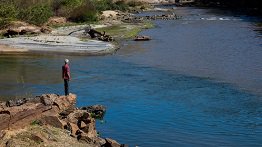
PUBLIC TENDER IS LAUNCHED FOR INTERESTED RESEARCHERS TO PARTICIPATE IN THE REPARATION PROCESS
Categories: Partnerships, Parcerias
Renova's participation on the fourth day of the 8th World Water Forum
Categories: World Water Forum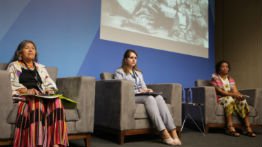
Discussions on sanitation, environmental crime and governance models marked the third day of the 8th World Water Forum
Categories: World Water Forum
Renova Foundation brings together experts for the collective elaboration of a term of reference on environmental risk
Categories: Renova Foundation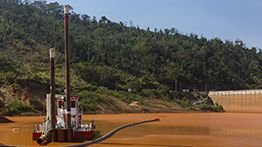
Learn more about the Tailings Management Plan drafted together with specialists, academics and civil society
Categories: Tailings Management
Tailings Management Plan is validated by environmental agencies
Categories: Tailings Management
Renova Foundation defines proposal for the management of tailings in the Doce River basin
Categories: Tailings Management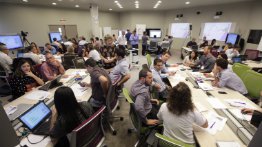
Experts discuss preliminary Doce River Tailings Management Plan
Categories: Tailings Management
Experts discuss guidelines for the tailings management plan of the Doce River basin
Categories: Tailings Management